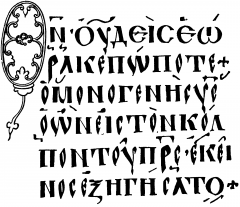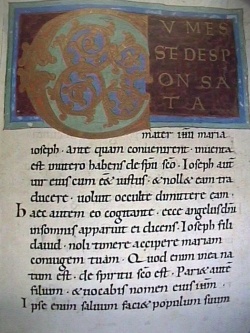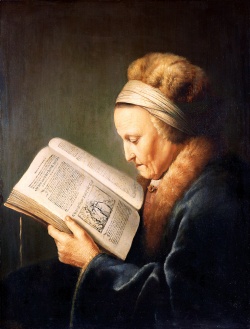Lectionary
From Textus Receptus
Nick (Talk | contribs)
(New page: Page from the 11th century "[[Bamberg Apocalypse", Gospel lectionary. Large decorated initial "C". Text from {{bibleverse||Matthe...)
Next diff →
Revision as of 11:25, 23 January 2011
A Lectionary is a book or listing that contains a collection of scripture readings appointed for Christian or Judaic worship on a given day or occasion.
Contents |
History
In all antiquity the Jews first read Scriptural selections randomly, but by the Medieval era had standardized a schedule of scripture readings to be read in the synagogue. A sequential selection was read from the Torah, followed by the "haftarah" – a selection from the prophetic books or historical narratives (e.g. "Judges," "Kings," etc.). Jesus probably read a providentially "random" reading when he read from Isaiah 61:1-2, as recorded in Luke 4:16-Luke 4:21|21]], when he inaugurated his public ministry. The early Christians adopted the Jewish custom of reading extracts from the Old Testament on the sabbath. They soon added extracts from the writings of the Apostles and Evangelists.[]
Both Hebrew and Christian lectionaries developed over the centuries. Typically, a lectionary will go through the scriptures in a logical pattern, and also include selections which were chosen by the religious community for their appropriateness to particular occasions.
The use of pre-assigned, scheduled readings from the scriptures can be traced back to the early church. Not all of the Christian Church used the same lectionary, and throughout history, many varying lectionaries have been used in different parts of the Christian world. Until the Second Vatican Council, most Western Christians (Catholics, Old Catholics, Anglicans, Lutherans, and those Methodists who employed the lectionary of Wesley) used a lectionary that repeated on a one-year basis. This annual lectionary provided readings for Sundays and, in those Churches that celebrated the festivals of saints, feast-day readings. The Eastern Orthodox Church and many of the Oriental Churches continue to use an annual lectionary. Within Lutheranism there remains an active minority of pastors and congregations who use the old one-year lectionary, often referred to as the Historic Lectionary.
Lectionaries from before the invention of the printing press contribute to understanding the textual history of the Bible. See also List of New Testament lectionaries.
Western Lectionaries
Catholic Mass Lectionary and the Revised Common Lectionary
After the Second Vatican Council of 1962–1965, the Holy See, even before producing an actual lectionary (in Latin), promulgated the Ordo Lectionum Missae (Order of the Readings for Mass), giving indications of the revised structure and the references to the passages chosen for inclusion in the new official lectionary of the Roman Rite of Mass. It introduced an arrangement by which the readings on Sundays and on some principal feasts recur in a 3-year cycle, with four passages from Scripture (including one from the Psalms) being used in each celebration, while on weekdays only three passages (again including one from the Psalms) are used, with the first reading and the psalm recurring in a 2-year cycle, while the Gospel reading recurs after a single year. This revised Mass Lectionary, covering much more of the Bible than the readings in the Tridentine Roman Missal, which recurred after a single year, has been translated into the many languages in which the Roman Rite Mass is now celebrated, incorporating existing or specially prepared translations of the Bible and with readings for national celebrations added either as an appendix or, in some cases, incorporated into the main part of the lectionary.
The Roman Catholic Mass Lectionary is the basis on which many Protestant lectionaries have been based, most notably the Revised Common Lectionary (RCL) and its derivatives, as organized by the Consultation on Common Texts (CCT) organization located in Nashville, Tennessee. Like the Mass Lectionary, they generally organize the readings for worship services on Sundays in a 3-year cycle, with four elements on each Sunday, and three elements during daily Mass:
- first reading from the Old Testament or, in Eastertide from certain books of the New Testament;
- responsorial Psalm (ideally, to be sung);
- second reading from one of the New Testament Letters (only on Sundays); and a
- Gospel reading.
3 year cycle
The lectionaries (both Catholic and RCL versions) are organized into three-year cycles of readings. The years are designated A, B, or C. Each yearly cycle begins on the first Sunday of Advent (the last Sunday of November or first Sunday of December). Year B follows year A, year C follows year B, then back again to A. We are currently (November 28, 2010) in Year A (The Gospel of St. Matthew.).
- Year A: Gospel of Matthew (November 2010 through 2011)
- Year B: Gospel of Mark (December 2011 through 2012)
- Year C: Gospel of Luke (December 2012 through 2013)
The Gospel of John is read throughout Easter, and is used for other liturgical seasons including Advent, Christmas, and Lent where appropriate.
Daily Lectionaries
The Roman Catholic lectionary includes a 2 year cycle for the weekday mass readings (called Cycle I and Cycle II). Odd-numbered years are Cycle I; even-numbered ones are Cycle II. The weekday lectionary includes a reading from the Old Testament, Acts, Revelation, or the Epistles, a responsorial Psalm, and a reading from one of the Gospels. These readings are generally shorter than those appointed for use on Sundays. The pericopes for the first reading along with the psalms are arranged in a 2-year cycle. The Gospels are arranged so that portions of all four are read every year. This weekday lectionary has also been adapted by some denominations with congregations that celebrate daily Eucharistic services. It has been published in the Episcopal Church's Lesser Feasts and Fasts and in the Anglican Church of Canada's Book of Alternative Services (among others).
This eucharistic lectionary should not be confused with the various Daily Office lectionaries in use in various denominations. The Consultation on Common Texts has produced a three-year Daily Lectionary which is thematically tied into the Revised Common Lectionary, but the RCL does not provide a daily Eucharistic lectionary as such. Various Anglican Churches have their own daily lectionaries, many of them adapted from that provided in the 1979 Book of Common Prayer.
Other lectionary information
In some churches, the Lectionary is carried in the entrance procession by a lector. In the Catholic Church, the Book of the Gospels is carried in by a deacon (when there is no deacon, a lector might process in with the Lectionary). When the Book of the Gospels is used, the first two readings are read from the Lectionary, while the Book of the Gospels is used for the final reading.
The Lectionary is not to be confused with a missal, gradual or sacramentary. While the Lectionary contains scripture readings, the missal or sacramentary contains the appropriate prayers for the service, and the gradual contains chants for use on any particular day. In particular, the gradual contains a responsory which may be used in place of the responsorial psalm.
Eastern Lectionaries
In the Eastern Churches (Eastern Orthodox, Oriental Orthodox, Byzantine Catholic, the Assyrian Church of the East, and those bodies not in communion with any of them but still practicing eastern liturgical customs) tend to retain the use of a one-year lectionary in their liturgy. Different churches follow different liturgical calendars (to an extent). Most Eastern Lectionaries provide for an Epistle and a Gospel to be read on each day.

Byzantine lectionary
Those churches (Eastern Orthodox and Byzantine Catholic) which follow the Rite of Constantinople, provide an Epistle and Gospel reading for most days of the year, to be read at the Divine Liturgy; however, during Great Lent there is no celebration of the Liturgy on weekdays (Monday through Friday), so no Epistle and Gospel are appointed for those days. As a historical note, the Greek lectionaries are a primary source for the Byzantine text-type used in the scholarly field of textual criticism.
Epistle and Gospel
The Gospel readings are found in a Gospel Book (Evangélion) and an Epistle Book (Apostól). There are differences in the precise arrangement of these books between the various national churches. In the Byzantine practice, the readings are in the form of pericopes (selections from scripture containing only the portion actually chanted during the service), and are arranged according to the order in which they occur in the church year, beginning with the Sunday of Pascha (Easter), and continuing throughout the entire year, concluding with Holy Week. Then follows a section of readings for the commemorations of Saints and readings for special occasions (Baptism, Funeral, etc.). In the Slavic practice, the biblical books are reproduced in their entirety and arranged in the canonical order in which they appear in the Bible.
The annual cycle of the Gospels is composed of four series:
- The Gospel of St. John
- read from Pascha until Pentecost Sunday
- The Gospel of St. Matthew
- divided over seventeen weeks beginning with the Monday of the Holy Spirit (the day after Pentecost). From the twelfth week, it is read on Saturdays and Sundays while the Gospel of St. Mark is read on the remaining weekdays
- The Gospel of St. Luke
- divided over nineteen weeks beginning on the Monday after the Elevation of the Holy Cross. From the thirteenth week, it is only read on Saturdays and Sundays, while St. Mark's Gospel is read on the remaining weekdays
- The Gospel of St. Mark
- read during the Lenten period on Saturdays and Sundays — with the exception of the Sunday of Orthodoxy.
The interruption of the reading of the Gospel of Matthew after the Elevation of the Holy Cross is known as the "Lukan Jump" The jump occurs only in the Gospel readings, there is no corresponding jump in the Epistle. From this point on the Epistle and Gospel readings do not exactly correspond, the Epistles continuing to be determined according to the moveable Paschal cycle and the Gospels being influenced by the fixed cycle.
The Lukan Jump is related to the chronological proximity of the Elevation of the Cross to the Conception of the Forerunner (St. John the Baptist), celebrated on September 23. In late Antiquity, this feast marked the beginning of the ecclesiastical New Year. Thus, beginning the reading of the Lukan Gospel toward the middle of September can be understood. The reasoning is theological, and is based on a vision of Salvation History: the Conception of the Forerunner constitutes the first step of the New Economy, as mentioned in the stikhera of the matins of this feast. The Evangelist Luke is the only one to mention this Conception (Luke 1:5-24).
In Russia, the use of the Lukan Jump vanished; however in recent decades, the Russian Church has begun the process of returning to the use of the Lukan Jump.
Old Testament Readings
Other Services have scriptural readings also. There is a Gospel lesson at Matins on Sundays and feast days. These are found in the Evangelion. There are also readings from the Old Testament, called "parables" (Paroemia), which are read at Vespers on feast days. These parables are found in the Menaion, Triodion or Pentecostarion. During Great Lent, parables are read every day at Vespers and at the Sixth Hour. These parables are found in the Triodion.
Syriac Orthodox

In the Syriac Orthodox Church, the lectionary begins with the liturgical calendar year on Qudosh `Idto (the Sanctification of the Church), which falls on the eighth Sunday before Christmas. Both the Old and the New Testament books are read except the books of Revelation, Song of Solomon, and I and II Maccabees. Scripture readings are assigned for Sundays and feast days, for each day of Lent and Holy Week, for raising people to various offices of the Church, for the blessing of Holy Oil and various services such as baptisms and funerals.
Generally, three Old Testament lections, a selection from the prophets, and three readings from the New Testament are prescribed for each Sunday and Feast day. The New Testament readings include a reading from Acts, another from the Catholic Epistles or the Pauline Epistles, and a third reading from one of the Gospels. During Christmas and Easter a fourth lesson is added for the evening service. The readings reach a climax with the approach of the week of the Crucifixion. Through Lent lessons are recited twice a day except Saturdays. During the Passion Week readings are assigned for each of the major canonical hours.
References
See also
- Book of Alternative Services
- Ekphonetic notation
- Gospel Book
- Lection
- Lector
- Liturgical year
- Manzil
- Mass (liturgy)
- Pericope
- Revised Common Lectionary
- The Text This Week
- Weekly Torah portion
- The Syro-Aramaic Reading of the Koran
External links
- Greek Orthodox Online Chapel lectionary Lectionary of the Greek Orthodox Church according to the typicon of the Ecumenical Patriarchate
- Books and Resources Books and resources to learn more about the Eucharistic lectionary.
- The Revised Common Lectionary
- The Roman Catholic Lectionary - based on the New American Bible, as approved by the United States Conference of Catholic Bishops (also used in the Philippines)
- General Introduction to the Lectionary (Roman Catholic)
- Lectionary of the Byzantine (Eastern Orthodox) Church
- The Joint Liturgical Group {UK) – which developed The Four Year Lectionary (One Gospel per Year)
- John Shearman's Liberal Lectionary
- The "Lukan Jump" Orthodox Research Institute
- Orthodox Christian Lectionary Explained (Russian Orthodox)
- Lectionary of the Syriac Orthodox Church
- Lectionary Central For the study and use of the traditional Western Eucharistic lectionary.
- Roman Catholic Lectionary for Mass Resources for the study of the current Roman Catholic lectionary.
- Historic Lectionary Lutheran one-year lectionary


